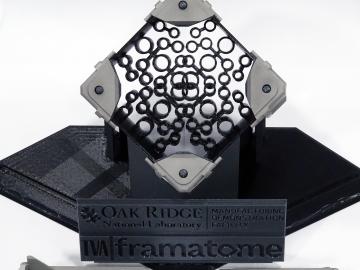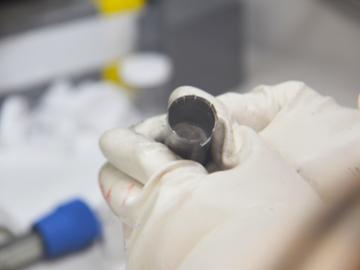
Filter News
Area of Research
- Advanced Manufacturing (4)
- Biological Systems (2)
- Biology and Environment (58)
- Computational Biology (1)
- Computational Engineering (1)
- Computer Science (1)
- Energy Science (32)
- Fusion and Fission (6)
- Fusion Energy (7)
- Materials (28)
- Materials for Computing (3)
- Mathematics (1)
- National Security (5)
- Neutron Science (12)
- Nuclear Science and Technology (9)
- Nuclear Systems Modeling, Simulation and Validation (1)
- Quantum information Science (7)
- Supercomputing (61)
News Type
News Topics
- (-) Advanced Reactors (26)
- (-) Bioenergy (86)
- (-) Clean Water (31)
- (-) Composites (22)
- (-) Frontier (46)
- (-) Physics (43)
- (-) Quantum Science (59)
- (-) Summit (48)
- 3-D Printing/Advanced Manufacturing (93)
- Artificial Intelligence (94)
- Big Data (67)
- Biology (102)
- Biomedical (55)
- Biotechnology (29)
- Buildings (55)
- Chemical Sciences (50)
- Computer Science (159)
- Coronavirus (31)
- Critical Materials (18)
- Cybersecurity (17)
- Education (2)
- Emergency (4)
- Energy Storage (69)
- Environment (172)
- Exascale Computing (52)
- Fossil Energy (7)
- Fusion (49)
- Grid (56)
- High-Performance Computing (94)
- Hydropower (12)
- Irradiation (2)
- Isotopes (40)
- ITER (7)
- Machine Learning (54)
- Materials (89)
- Materials Science (98)
- Mathematics (12)
- Mercury (10)
- Microelectronics (3)
- Microscopy (38)
- Molten Salt (7)
- Nanotechnology (33)
- National Security (66)
- Neutron Science (112)
- Nuclear Energy (90)
- Partnerships (37)
- Polymers (21)
- Quantum Computing (39)
- Security (19)
- Simulation (53)
- Software (1)
- Space Exploration (23)
- Statistics (3)
- Transportation (71)
Media Contacts

Since the 1930s, scientists have been using particle accelerators to gain insights into the structure of matter and the laws of physics that govern our world.

Marcel Demarteau is director of the Physics Division at the Department of Energy’s Oak Ridge National Laboratory. For topics from nuclear structure to astrophysics, he shapes ORNL’s physics research agenda.

As ORNL’s fuel properties technical lead for the U.S. Department of Energy’s Co-Optimization of Fuel and Engines, or Co-Optima, initiative, Jim Szybist has been on a quest for the past few years to identify the most significant indicators for predicting how a fuel will perform in engines designed for light-duty vehicles such as passenger cars and pickup trucks.

There are more than 17 million veterans in the United States, and approximately half rely on the Department of Veterans Affairs for their healthcare.

New capabilities and equipment recently installed at the Department of Energy’s Oak Ridge National Laboratory are bringing a creek right into the lab to advance understanding of mercury pollution and accelerate solutions.

The Transformational Challenge Reactor, or TCR, a microreactor built using 3D printing and other new advanced technologies, could be operational by 2024.

Popular wisdom holds tall, fast-growing trees are best for biomass, but new research by two U.S. Department of Energy national laboratories reveals that is only part of the equation.

Irradiation may slow corrosion of alloys in molten salt, a team of Oak Ridge National Laboratory scientists has found in preliminary tests.


Rufus Ritchie came from Kentucky coal country, a region not known for producing physicists.


